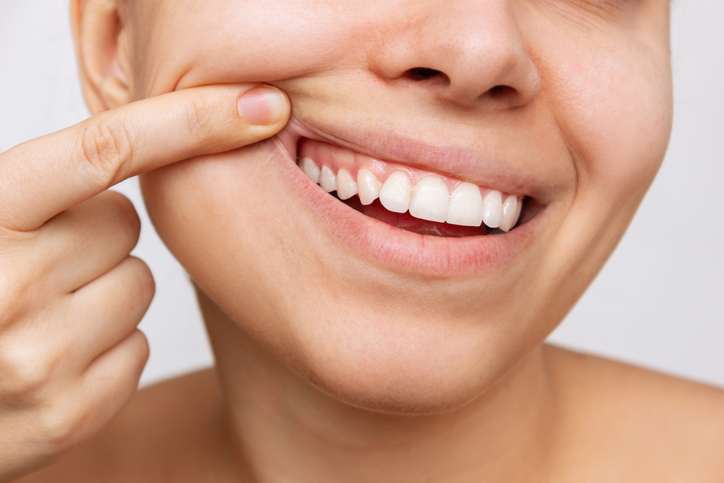
In this blog, we’ll be discussing two popular treatments for gum discoloration: gum depigmentation and gum bleaching. We’ll cover the causes of gum discoloration, the benefits and risks of each treatment, and how to choose the right one for you. Our goal is to provide you with the information you need to make an informed decision about your dental health and aesthetics.
At Implant & Perio Center of Kansas, we understand the importance of a beautiful smile. Our experienced periodontist, Dr. Marq J. Sams is dedicated to helping our patients achieve their desired results. We offer a range of cosmetic periodontal treatments, including gum depigmentation and bleaching, to help you feel confident and proud of your smile. So, let’s dive in and explore the world of aesthetic gum treatments!
Causes of Gum Discoloration
Gum discoloration is a common dental problem that affects many people. There are several factors that can cause gum discoloration, including genetics, smoking, medications, poor oral hygiene, and other factors.
Genetics play a significant role in gum discoloration. Some people are born with darker gums, which can be more noticeable if they have thin or receding gums. Smoking is another common cause of gum discoloration. The nicotine and tar in cigarettes can stain the gums and teeth, leading to a yellow or brownish color.
Certain medications can also cause gum discoloration. For example, some antibiotics, antipsychotics, and antihypertensive drugs can cause the gums to darken. Poor oral hygiene can also contribute to gum discoloration. If you don’t brush and floss regularly, plaque and tartar can build up on your teeth and gums, leading to discoloration.
Other factors that can cause gum discoloration include hormonal changes, such as during pregnancy or menopause, and certain medical conditions, such as Addison’s disease or hemochromatosis.
If you’re experiencing gum discoloration, it’s important to talk to your dentist. They can help determine the cause of your discoloration and recommend the best treatment options for you. In the next sections, we’ll discuss two common treatments for gum discoloration: gum depigmentation and gum bleaching.
Gum Depigmentation Treatment
Gum depigmentation is a cosmetic procedure that involves removing dark spots or patches on the gums. This discoloration can be caused by genetics, smoking, medications, poor oral hygiene, or other factors. While it is not a health concern, it can affect the appearance of your smile and cause self-consciousness.
During the procedure, a periodontist will use a laser or scalpel to remove the pigmented layer of the gums. This will reveal the lighter, natural color of the gums underneath. The procedure is typically painless and can be completed in one visit.
The benefits of gum depigmentation include a more even and aesthetically pleasing gum line, increased confidence in your smile, and improved oral hygiene. However, there are some risks and side effects to consider, such as temporary sensitivity, swelling, or discomfort.
After the procedure, it is important to follow our aftercare instructions, which may include avoiding certain foods or activities for a few days. It is also important to maintain good oral hygiene habits to prevent future discoloration.
If you are considering gum depigmentation, it is important to consult with a periodontist to determine if it is the right treatment for you. Factors to consider include the severity of the discoloration, your overall oral health, and any insurance coverage or cost considerations.
Gum Bleaching Treatment
Gum bleaching is a cosmetic dental procedure that lightens the color of dark or discolored gums. This treatment is ideal for patients who are unhappy with the appearance of their gums due to genetics, medication, or other factors. The procedure involves applying a special bleaching agent to the gums, which is then activated with a laser or light. The bleaching agent penetrates the gum tissue and breaks down the pigments that cause discoloration.
The benefits of gum bleaching include a more uniform and aesthetically pleasing gum line, improved self-confidence, and a brighter smile. However, like any dental procedure, there are risks and side effects to consider. These may include sensitivity, discomfort, and temporary discoloration of the gums.
After the procedure, patients will need to follow specific aftercare instructions to ensure proper healing and minimize discomfort. This may include avoiding certain foods and drinks, using a special mouthwash, and taking pain medication as needed.
When choosing between gum depigmentation and bleaching, it’s important to consider factors such as the cause of discoloration, the extent of the discoloration, and the patient’s overall oral health. A consultation with a periodontist can help determine the best course of treatment for each individual patient.
Choosing the Right Treatment
When it comes to choosing between gum depigmentation and bleaching, there are several factors to consider. First and foremost, it’s important to consult with a periodontist to determine which treatment is best for your specific needs. They will be able to evaluate the severity of your gum discoloration and recommend the most effective treatment option.
Another factor to consider is cost and insurance coverage. While both treatments can be costly, some insurance plans may cover a portion of the cost. It’s important to check with your insurance provider to see what is covered and what isn’t.
Success stories from previous patients can also be helpful in making a decision. Our patients have had great success with both gum depigmentation and bleaching treatments, and their experiences can provide valuable insight into what to expect.
Ultimately, the decision between gum depigmentation and bleaching comes down to personal preference and the severity of your gum discoloration. Both treatments have their benefits and risks, and it’s important to weigh these factors carefully before making a decision.
At Implant & Perio Center of Kansas, we are committed to helping our patients achieve the best possible results. If you’re considering gum depigmentation or bleaching, we invite you to schedule a consultation. We’ll work with you to determine the best treatment option for your needs and help you achieve a brighter, more confident smile. Contact us today!
